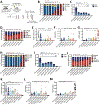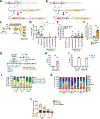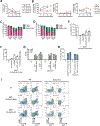Exonic knockout and knockin gene editing in hematopoietic stem and progenitor cells rescues RAG1 immunodeficiency
- PMID: 38324638
- PMCID: PMC11149094
- DOI: 10.1126/scitranslmed.adh8162
Exonic knockout and knockin gene editing in hematopoietic stem and progenitor cells rescues RAG1 immunodeficiency
Abstract
Recombination activating genes (RAGs) are tightly regulated during lymphoid differentiation, and their mutations cause a spectrum of severe immunological disorders. Hematopoietic stem and progenitor cell (HSPC) transplantation is the treatment of choice but is limited by donor availability and toxicity. To overcome these issues, we developed gene editing strategies targeting a corrective sequence into the human RAG1 gene by homology-directed repair (HDR) and validated them by tailored two-dimensional, three-dimensional, and in vivo xenotransplant platforms to assess rescue of expression and function. Whereas integration into intron 1 of RAG1 achieved suboptimal correction, in-frame insertion into exon 2 drove physiologic human RAG1 expression and activity, allowing disruption of the dominant-negative effects of unrepaired hypomorphic alleles. Enhanced HDR-mediated gene editing enabled the correction of human RAG1 in HSPCs from patients with hypomorphic RAG1 mutations to overcome T and B cell differentiation blocks. Gene correction efficiency exceeded the minimal proportion of functional HSPCs required to rescue immunodeficiency in Rag1-/- mice, supporting the clinical translation of HSPC gene editing for the treatment of RAG1 deficiency.
Conflict of interest statement
Figures






References
-
- Schatz DG, Swanson PC, V(D)J Recombination: Mechanisms of Initiation. Annu Rev Genet 45, 167–202 (2011). - PubMed
-
- Dvorak CC, Haddad E, Heimall J, Dunn E, Cowan MJ, Pai S-Y, Kapoor N, Satter LF, Buckley RH, O’Reilly RJ, Chandra S, Bednarski JJ, Williams O, Rayes A, Moore TB, Ebens CL, Davila Saldana BJ, Petrovic A, Chellapandian D, Cuvelier GDE, vander Lugt MT, Caywood EH, Chandrakasan S, Eissa H, Goldman FD, Shereck E, Aquino VM, Desantes KB, Madden LM, Miller HK, Yu L, Broglie L, Gillio A, Shah AJ, Knutsen AP, Andolina JP, Joshi AY, Szabolcs P, Kapadia M, Martinez CA, Parrot RE, Sullivan KE, Prockop SE, Abraham RS, Thakar MS, Leiding JW, Kohn DB, Pulsipher MA, Griffith LM, Notarangelo LD, Puck JM, The diagnosis of severe combined immunodeficiency: Implementation of the PIDTC 2022 Definitions. Journal of Allergy and Clinical Immunology 151, 547–555.e5 (2023). - PMC - PubMed
Publication types
MeSH terms
Substances
Grants and funding
LinkOut - more resources
Full Text Sources
Molecular Biology Databases

